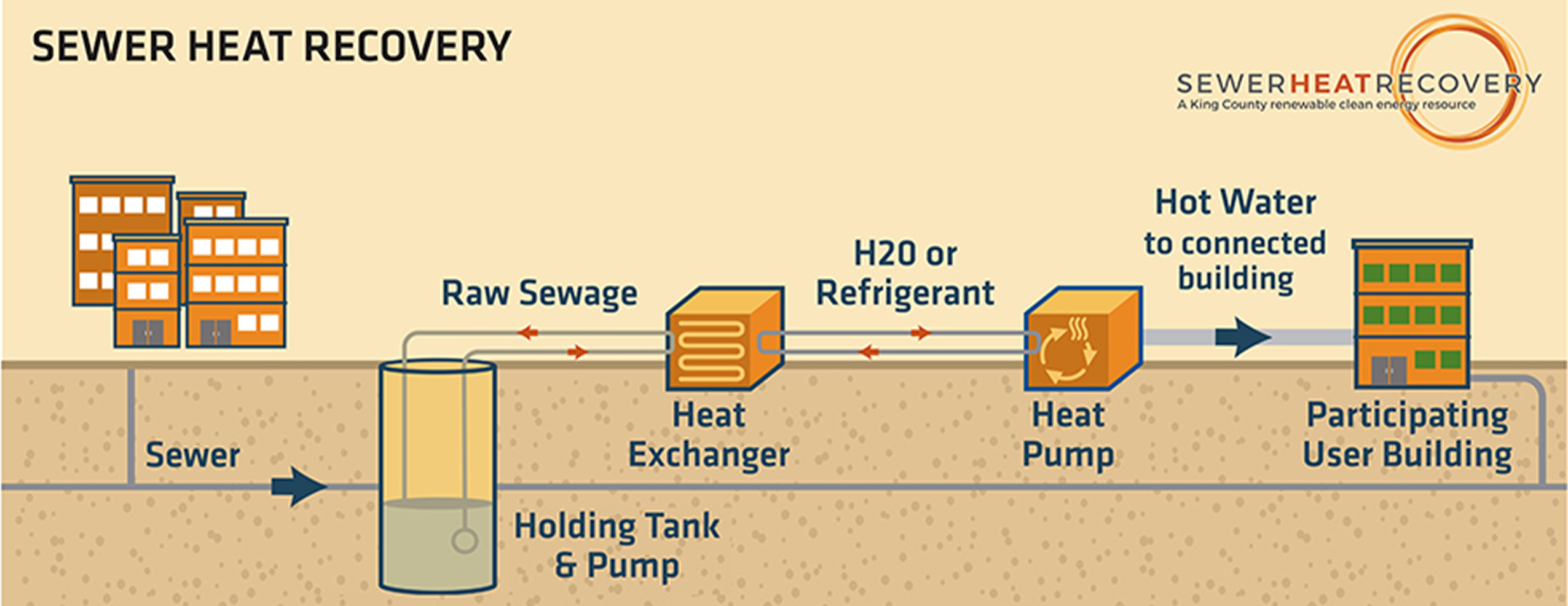In October 2023, the King County Wastewater Treatment Division, which operates a 424-square-mile service area across the Puget Sound region, announced a new public-private partnership to provide heat from its municipal sewer line to a new 1.6 million-square-foot mixed-use life sciences campus in urban Seattle. Commercial developer Alexandria Real Estate Equities, Inc. is tapping into the conveyance pipe to transfer enough heat to provide 70% of the heating in this five-building campus – making this one of the first large commercial projects in the nation to draw heat from the sewer system as a renewable energy source for buildings.
“As a wastewater utility, we are offering sewer heat as a renewable resource that can be one solution to the climate crisis,” said Drew Thompson, King County’s lead for the Sewer Heat Recovery Program. “By partnering with commercial developers, we can leverage our impact to meet King County’s goals to reduce greenhouse gases from the built environment.”

[Above] This illustration is an example of how the sewer heat system can work to provide a renewable source of heating and cooling for buildings.
The project reached a significant milestone in Summer 2023 when crews cut and connected one of the County’s original 100-year-old brick-lined sewer lines to Alexandria’s system, proving that such a system can be installed in a dense, urban landscape.
Already in use in other countries such as Canada, Germany, and Japan, sewer heat recovery is an affordable, renewable energy alternative to traditional methods used to heat and cool buildings. While there are a few notable projects in the U.S., the advancement of this technology in this country has been stymied by the lack of standardized use agreements in place by local utilities. That’s created a barrier between utilities that have sewer heat to offer and private entities interested in tapping into this public resource.

[Left] The SHARC Energy system is the sewer heat recovery technology installed in the new commercial campus in Seattle. It is in use in several other locations in the U.S. and internationally.
[Right] King County Executive Dow Constantine and project partners learn about the new Seattle commercial campus will receive sewer heat generated from County conveyance line.
King County began receiving calls 15 years ago from interested parties who had heard about the success of sewer heat recovery elsewhere in the world, including just to the north in Vancouver, British Columbia. The Wastewater Treatment Division began to explore options, eventually leading to a pilot program with private users that determined eligibility for the program and a template agreement that set the technical and legal requirements in place.
Alexandria is the first company to sign the agreement with King County to install the technology, leaving two remaining open spots in the program for other commercial entities. Users are responsible for designing, constructing, operating, and maintaining the systems. Users also pay King County for costs associated with reviewing project designs and an energy transfer fee of one-half cent per ton-hour of energy transferred following the first three years of service. The benefits to commercial users are reduced energy and potable water costs, contributions to green building certification, and financing support to meet regional energy code requirements.

[Left] In an urban neighborhood in Seattle, crews cut into King County’s 100-year old brick-lined conveyance line to establish a connection to the sewer heat recovery technology that will power the new life-sciences commercial campus.
The heat transfer system in use by Alexandria was developed and manufactured by British Columbia-based SHARC Energy and can be used for traditional heating and cooling purposes. It involves a system of closed-loop pipes that exchange heat from the sewer system into a hydronic system that is pumped through a building. In Seattle, the wastewater temperature in the sewer system is remarkably consistent and reliable, helping the heat transfer work well.
As a leader in resource recovery and climate action, King County is making its template use agreement available for other municipalities to use so that it can be adapted elsewhere in the country to help spur the development of similar heat energy recovery projects.